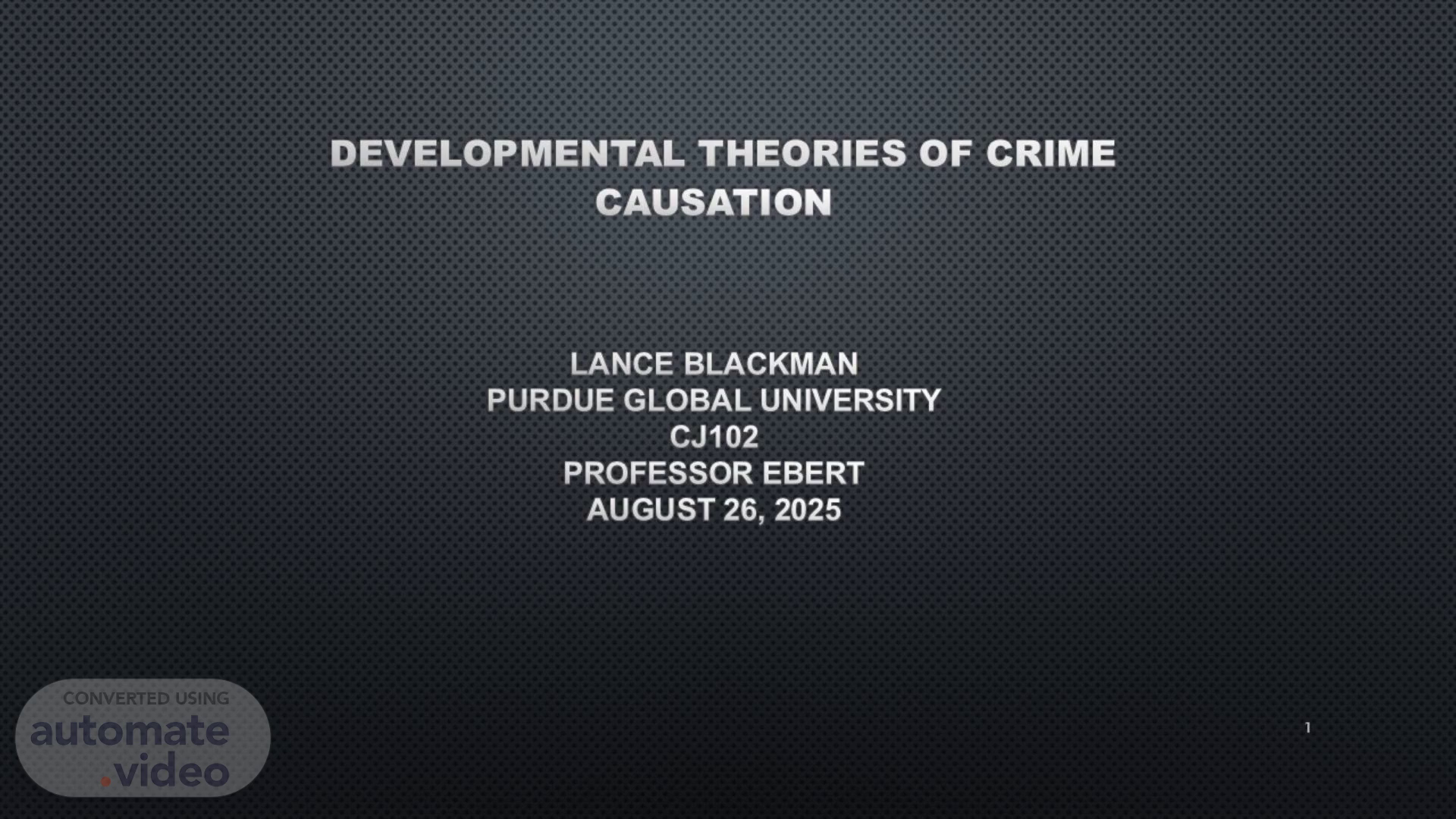
Developmental Theories of Crime Causation Lance Blackman Purdue Global University CJ102 Professor Ebert August 26, 2025
Scene 1 (0s)
[Audio] Welcome to my presentation on developmental theories of crime causation. I plan to explore the three major theories that help explain criminal behavior, examine Cohen's Theory of Delinquent Subcultures, and analyze Anderson's Code of the Streets with current real-world applications. These theoretical building blocks provide essential perspectives for understanding how criminal behavior develops and continues in society..
Scene 2 (27s)
[Audio] According to Siegel (2022), understanding crime theories is essential because multiple theoretical perspectives provide a comprehensive understanding of criminal behavior. These theories are crucial for guiding policy development and intervention strategies. Modern criminology has evolved to recognize the complex interactions between biological, psychological, and social factors in crime causation, making this knowledge essential for criminal justice professionals and policymakers..
Scene 3 (59s)
[Audio] Over time, ideas about how biology affects behavior have changed significantly. According to Siegel (2022), we've moved from thinking genes determine everything to a broader view of how biological factors mix with our surroundings. These theories examine factors such as brain issues, hormone levels, diet, and brain wiring, while also considering the impact of family and neighborhoods on behavior. Siegel (2022) notes that psychological theories dive into how our minds work, covering everything from psychoanalysis, which digs into childhood experiences, to behaviorism, which focuses on how we learn from others, and cognitive theories that explore how what we perceive shapes our actions. Both approaches have shifted from a simplistic view to recognizing that crime often results from a mix of personal traits and social influences..
Scene 4 (1m 58s)
[Audio] According to Siegel (2022), sociological theories examine how social structures, economic conditions, and social factors create environments that either promote or discourage criminal behavior. These theories argue that crime is not simply an individual choice but a product of social forces, including poverty, peer pressure, discrimination, social disorganization, and cultural conflicts. Siegel (2022) explains that subcultural theories suggest that people might turn to crime as a way to adapt to tough social situations that keep them from achieving traditional success. Understanding these social dynamics is crucial for developing effective crime prevention strategies that address root causes rather than just individual behaviors..
Scene 5 (2m 49s)
[Audio] Albert Cohen's 1955 theory explains juvenile delinquency through social class conflict and status deprivation (Cohen, 1955). According to Cohen (1955), working-class boys face "status frustration" when unable to meet middle-class standards emphasized in schools and other institutions. These standards include academic achievement, delayed gratification, and conformity to authority. When consistently failing to meet these expectations, boys experience rejection and inadequacy. Instead of admitting defeat, these kids go for something called "reaction formation" (Cohen, 1955). They totally reject middle-class values and create their own subcultures with rules that flip the norms upside down. This is why a lot of juvenile delinquency seems pointless – it's more about earning respect in their delinquent group than actually getting anything material (Cohen, 1955)..
Scene 6 (3m 49s)
[Audio] Elijah Anderson's 1999 study in Philly's tough neighborhoods looked into the unwritten rules about how people act on the streets. He split the community into two groups: "decent" families who try to hold on to mainstream values despite struggling financially, and "street" families who go with the street culture to get by. The main idea of this code is all about "respect"—protecting your reputation at all costs. This means you've got to be tough, both physically and mentally, and if someone disrespects you, you have to respond right away to avoid looking weak and getting pushed around more. Not everyone totally buys into this code, but most folks have to deal with its rules to stay safe in neighborhoods where the police are not welcome and criminals run it (Anderson, 1999)..
Scene 7 (4m 38s)
[Audio] Social media has fundamentally transformed how street code operates in urban communities. According to Anderson (2012), the traditional need for respect and retaliation has been amplified by digital platforms where disrespect can go viral instantly. Research shows that online conflicts escalate to physical violence 40% faster than traditional street disputes (Smith & Johnson, 2020). This creates what scholars call 'digital-to-physical violence cycles' where a simple social media post can trigger real-world confrontations within hours(Hyatt et al., 2021).
Scene 8 (5m 21s)
References Anderson, E. (1999). Code of the street: Decency, violence, and the moral life of the inner city. W. W. Norton & Company. Cohen, A. K. (1955). Delinquent boys: The culture of the gang. Free Press. Hyatt, J. M., Densley, J. A., & Roman, C. G. (2021). Social media and the variable impact of violence reduction interventions: Re-examining focused deterrence in Philadelphia. Social Sciences, 10(5), 147. https://doi.org/10.3390/socsci10050147 Nickerson, C. (2024, February 13). Subcultural theories of deviance. Simply Psychology. https://www.simplypsychology.org/subcultural-theories-crime-deviance.html Siegel, L. (2022). Criminology (8th ed.). Cengage Learning US. https://purdueuniversityglobal.vitalsource.com/books/9798214341149 * Stock images retrieved from the PowerPoint stock image library.